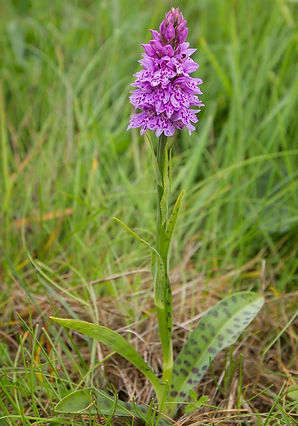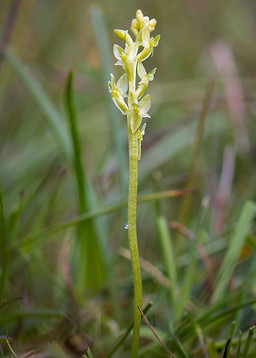
Orchidaceae (Orchids) 10 species
Orchids are probably the most popular and amongst the most spectacular of British flowering plants, and there have been many books written about them. In Shetland, there are two species which could be described as abundant and will even grow on garden lawns, and they are one of the native plants with a Shetland name curly-dodies. In, all ten species are known from the islands, but one is (presumably) extinct.
Although it is usually easy to recognise an orchid, it may be quite difficult to allocate an individual to a species, as they have a tendency to hybridize freely, producing a great variety of forms, particularly in the genus Dactylorhiza. Hybrids are often the largest and showiest plants, due to a process known as 'hybrid vigour'. The following list of Shetland orchids is arranged approximately in the order they are likely to be encountered. The accounts draw heavily upon the published work of the late Walter Scott.
Heath Spotted Orchid Dactylorhiza maculatum
The commonest orchid in Shetland, found from moorland to rough pasture in croft land. Usually relatively small with delicate pink flowers and heavily spotted leaves.



Heath Spotted Orchids Mike Pennington
Northern Marsh Orchid Dactylorhiza purpurella
A very common species in marshy or wet grassland, but also found on lawns and roadside. Rather variable in appearance.


Northern Marsh Orchids Jim Nicolson Mike Pennington
Hybrid Northern Marsh x Heath Spotted Orchid Dactylorhiza x formosa
Possibly as common as Northern Marsh in some places, and tends to refer the damper soils of Northern. Often large and showy due to hybrid vigour. (Hybrids between other species may occur, but none are as frequent as this).



hybrid orchids Larry Dalziel Mike Pennington (x2)
Early Marsh Orchid Dactylorhiza incarnata
Three subspecies are found in Shetland. The nominate incarnata with candy-pink flowers is fairly frequent in south and central Mainland and rarer in north and west Mainland, Unst, Fetlar and Fair Isle. It prefers marshy base-rich pasture on suitable substrates such as sandstone or limestone. The subspecies coccinea, with crimson-pink flowers is locally common in south Mainland, often in sandy soils. The subspecies pulchella with purple flowers is only known from a few sites in pasture on Unst and one on Whalsay. A characteristic of the flowers of this species is that the lower lip folds back at the sides.



Early Marsh Orchids subsp. incarnata Larry Dalziel subsp. coccinea Larry Dalziel subsp. pulchella Mike Pennington
Frog Orchid Coeloglossum viride
An inconspicuous species that is easily overlooked but which is quite frequent in short grassland on coasts, limestone pasture, serpentine pasture or fellfield such as the Keen of Hamar and Ronas Hill.



Frog Orchids Jim Nicolson Larry Dalziel Mike Pennington
Lesser Twayblade Listera cordata
An extremely inconspicuous and often minsicule species that is probably fairly widespread on boggy moorland but which is probably widespread wherever Heather Calluna vulgaris and Sphagnum moss grow together.



Lesser Twayblades Larry Dalziel Mike Pennington (x2)
Common Spotted Orchid Dactylorhiza fuchsii
Known from just four areas. Reasonably frequent in south Mainland from Spiggie and Clumlie to Sumburgh and in south Cunningsburgh and scarce at two sites on Unst. Similar to Heath Spotted in general colour and appearance but the lower lip of the flower usually has a large central lobe.

Common Spotted Orchid Larry Dalziel
Early Purple Orchid Orchis mascula
Known from just three areas, where it can be quite frequent: on limestone in Whiteness and in serpentine heath on Fetlar and in Unst, mainly on or near the Keen of Hamar Nature Reserve.


Early Purple Orchids Larry Dalziel Jim Nicolson
Bog Orchid Hammarbya paludosa
A tiny inconspicuous green orchid that is probably commoner than its current status suggests. It may well be discovered elsewhere but finding it is difficult and often the result of good luck. It grows in wet places amongst Sphagnum moss and Yell has been the main location, with five sites known on the island, the first located in 1961. It was also found in a floristic survey of Papa Stour in 1980, but has not really been looked for there since. In ????, it was discovered on Mainland for the first



Bog Orchids Larry Dalziel
Heath Fragrant Orchid Gymnadenia borealis
Only currently known from one site, the Keen of Hamar Nature Reserve on Unst, where it grows on serpentine pasture on the north side of the reserve. In a good year, there may be as many as 100 flowering spikes. It has been seen at two other nearby sites in Baltasound, but not since 1984. Four old reports, all from 1924 or earlier, elsewhere on Unst or in north and south Mainland, all require confirmation. The fragrant orchids were split into three species relatively recently following DNA investigations.


Heath Fragrant Orchid Larry Dalziel Mike Pennington
Narrow-leaved Orchid Dactylorhiza traunsteineroides
Only very recently added to the Shetland list, in 2018, when a small and vulnerable colony was found in north Mainland. Another small colony was found on Unst on 2020.


Narrow-leaved Orchids Larry Dalziel Mike Pennington
Small White Orchid Pseudorchis albida
The Holy Grail for the Shetland orchid-hunter. It was recorded twice in the early 19th century, on Bressay and Unst, but has never been seen since. It is still found as close as Orkney so maybe, just maybe, it may be rediscovered in Shetland.
Written by Mike Pennington Updated 7th Ju;y 2020
with contributions from Paul Harvey and incorporating information from Shetland Biological Records Centre



